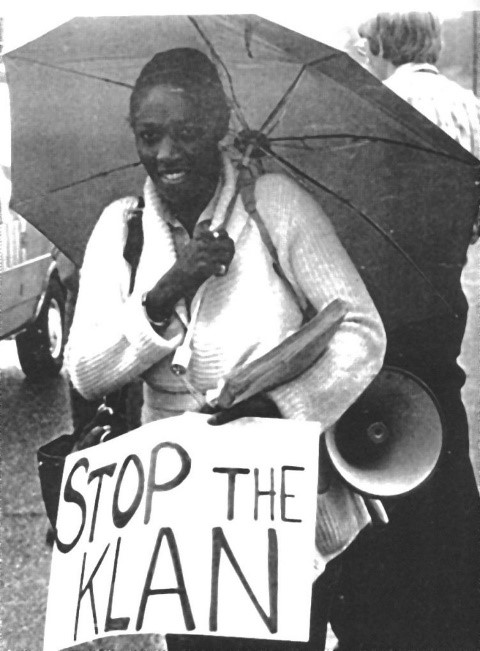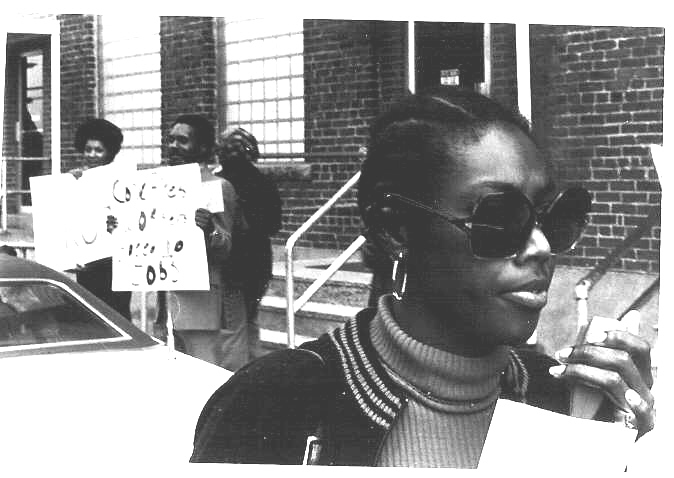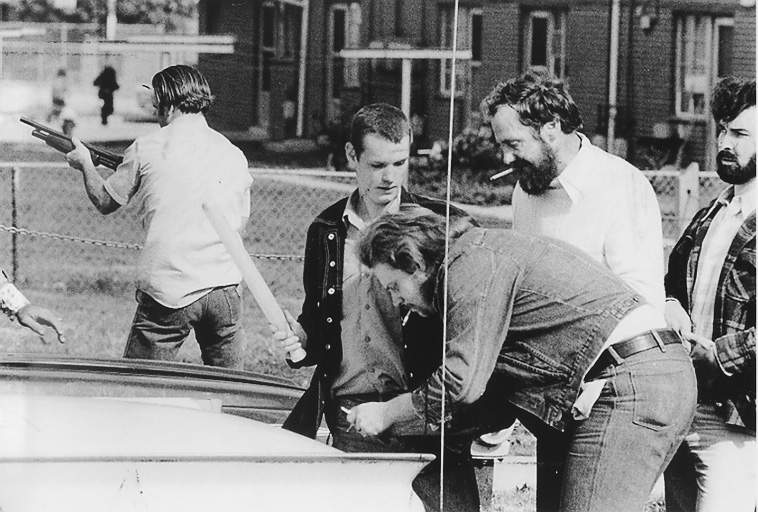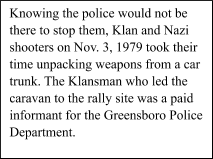An Apology for a Massacre
41 Years Later
|

Public accountability for their actions often awaits evildoers who hurt people. For many who spilled onto the streets in a mood of relief, jubilation and celebration at the election news of a soon-to-be outgoing president, a day of reckoning for the nation had come. Only weeks earlier, a Southern city cautiously enacted its overdue moral reckoning with an apology for a massacre. The Rev. Dr. Martin Luther King’s famous proclamation, “the arc of the moral universe is long, but it bends towards justice,” is an applicable lens for these events.
On November 3, 1979, in Greensboro, North Carolina, at approximately 11:20 on a bright Saturday morning, nine carloads of Ku Klux Klansmen and American Nazis drove into the preparation site of a legally permitted anti-Klan rally. Opening fire on the crowd, they shot and killed five people, wounded ten others, and terrorized the poor Black public housing community of Morningside Homes. No uniformed police were visible at the rallying site, which was most unusual.
Furthermore, the police acted unconstitutionally to disarm the marchers by banning weapons as a condition for obtaining the parade permit. We, the authors of this article, were there and were among the widowed and wounded survivors. Nelson was the main organizer of the planned events of the day that were to include the morning rally, a march through town and an afternoon labor conference. I, Signe, was one of several co-organizers.
Fast forward to almost forty-one years later: In late evening of October 6, 2020, the Greensboro City Council voted seven to two to make an official apology of substance to the widows, survivors, and residents of Morningside Homes for the roles that the City of Greensboro and the Greensboro Police Department played in facilitating the 1979 Greensboro Massacre and its subsequent cover up.
Greensboro now acknowledges that its police department (GPD), “along with other city personnel failed to warn the marchers of their extensive foreknowledge of the racist, violent attack planned against the marchers by members of the Ku Klux Klan and the American Nazi Party with the assistance of a paid GPD informant.”
The apology further concedes that “the GPD failed to divert, stop or arrest the members of the Ku Klux Klan and American Nazi Party, whom police knew were carrying a cache of concealed weapons, as they approached the Morningside Homes Community where the marchers were gathered.” Carrying concealed weapons is illegal in N.C.
The Resolution of Apology alludes to “an atmosphere of blaming the victims of the Greensboro Massacre,” as this horrific incident has come to be known.
Most meaningfully, the City of Greensboro resolves to “honor five students annually with a monetary academic award, one each in the memory of César Cauce, Dr. James Waller, William Evan Sampson, Sandra Neely Smith and Dr. Michael Nathan.” The Scholarships will be awarded to students at Dudley High School, a mainly Black school, for essays or artistic expressions focused on issues of racial and social justice. Thus, instead of those killed being vilified and dismissed as communists, their names will be acknowledged publicly and respectfully each year.



The Communist Workers Party Five were the flowers of their generation. They were our rainbow race. Black, white, Latino, Christian, Jewish, Male, Female—they were all, in their souls, in their characters, all we who knew them aspire to be.










Serious, dedicated, smart, loving, funny, humble, joyous, intent on being of service to their fellow humans—no matter what the cost. Lovers of justice and haters of injustice. Willing to do more than just posture, feel, think, talk, dream and imagine. Yes, willing to act. Acting. Just do it! Be there when you say you will be there. Live a life of meaning. A life of caring and compassionate doing. Take the high road, never the easy road. Your word is your bond and your bond is one of love and your love is full of courage. Our rainbow race.
But why bother about a white supremacist attack of two generations ago when the danger of violent white supremacist action is all around us today? Precisely. We ignore our past or choose not to learn from it at our own peril. Truth matters. In the convergence of existential crises facing us today, from state-sponsored white supremacist atrocities to the reckless destruction of our life-sustaining planet, truth matters and is a matter of life and death.
We believe that we speak for other survivors when we assess the current climate of fear, falsehoods and threats of massive force in our nation as being eerily similar to the atmosphere in Greensboro in the days, months and years following the Massacre. This eerie similarity is revealed when white supremacist extremists show up, break the law and are indulged by a police culture that often sees them as heavily armed friendlies. White supremacist forces have been unleashed by the divisive rhetoric emanating from the highest levels of our political system.
In Charlottesville, VA, in 2017, police stood by as violent street fighting raged for hours, leading to a death and several injuries when a right-wing extremist used his car as a murder weapon. Some Charlottesville citizens, including the Mayor, later visited Nelson and Joyce Johnson, Co-Executive Directors of Greensboro’s Beloved Community Center (BCC), having connected what happened to them with police collusion with Klansmen and Nazis in Greensboro in 1979.
The situation of an unleashed right wing has gotten worse. Forty years ago, the police and the courts had to lie, and demonize the survivors and those killed to cover up their misdeeds. Today, white supremacists expose themselves in blatant disregard for the Constitution and civil and human rights and are openly defiant about breaking longstanding moral and legal protocols. Upside-down justice has caused a system break-down that leaves chaos, confusion and fascism in its wake.
The Greensboro Massacre is a political story with moral and spiritual depth. The five people killed were accomplished organizers who united workers across racial and gender divides to struggle together for safe working conditions and democratic trade unions. Their successful organizing was potentially threatening to the status quo of the city’s financial elite. The afternoon labor conference that was to be the main event on November 3, 1979 never happened because of the assassinations that morning. Its purpose was to unite Black and white workers from the surrounding textile mills and to facilitate community building between the workers and Greensboro’s broader Black population.
Only after two all-white juries, in a state trial for murder and federal trial for civil rights’ violations, acquitted all Klansmen and Nazis, was there a flicker of justice for the daylight murders. In a civil suit brought by massacre survivors in 1985, with one Black juror, an historic and unprecedented verdict found four Klansmen, two Nazis and two Greensboro police officers jointly liable for wrongful death. The City of Greensboro paid a paltry $351,000 judgment but denied any wrongdoing while the Klan and Nazi attackers paid nothing.
These are no ordinary times. In April of 2020, as the global pandemic raged, armed militia men invaded the State House in Lansing, Michigan, with no push-back from police. A day later, the President tweeted “Liberate Michigan.” Fourteen men have now been arrested for a plot to kidnap Governor Gretchen Whitmer.
In May of 2020, the brutal killing of George Floyd while in police custody in Minneapolis set off hundreds of protests across the county. According to a Huffington Post article, “White Vigilantes Have Always Had a Friend in Police,” far-right vigilantes, often with police support, threatened protesters in nearly five hundred incidents in the three-month period following Floyd’s murder. White supremacist threats to African Americans and the Black Lives Matter Movement, in order of magnitude, is more chilling now than in the period of the Greensboro Massacre.
The steady militarization of local police forces has equipped police with a variety of weapons of war that cause great injury and suffering. In some cities these are being used almost routinely against peaceful protestors. Physicians for Human Rights has tracked these weapons, the injuries they cause and their use in Portland, Oregon. Their Oct. 8, 2020 report on the dangerous use of crowd-control weapons against protestors and medics tells us what we must prepare to resist.
In Greensboro, we invited residents and media representatives to celebrate with us and to see the City Council’s Apology as a People’s Victory –one that challenges us to organize and unite more effectively than ever before. The question remains, what has the City of Greensboro learned from its apology for the massacre of 1979.
Many local residents feel that the GPD has the same entrenched culture as decades ago, marked by racism, excessive use of force and lack of accountability. They point to the two-year-old case of Marcus Deon Smith, who some now see as Greensboro’s George Floyd. Smith was a black homeless man experiencing a mental health crisis and walking erratically through street traffic when he asked police to help him. He was not a threat, had not committed a crime and had not been charged, but he soon ended up “hogtied” in a dangerous maximum restraint device known to cause asphyxiation. He died in police custody a few moments later, bound face down on the ground and unable to breathe. The Chief Medical Examiner of the state of North Carolina pronounced Marcus’ death a homicide. Greensboro has spent over $400,000 of taxpayer money thus far for outside lawyers in an attempt to have a civil suit by Marcus’ family dismissed instead of reaching a fair settlement with them. A determined coalition of area social and racial justice groups has been fighting hard for an acknowledgment of police culpability and a just settlement. Although both the reprehensible action and inaction of eight police officers is shown in police bodycam footage for all to see, the City Council has yet to examine deeply and honestly Greensboro’s time-worn issue of police misconduct. The apology for the massacre is one step in the right direction, but there is much work left to do: It is time for a fresh orientation toward matters of injustice.

Greensboro initiated the nation’s first Truth and Reconciliation Commission (TRC) in 2004 to study the 1979 Massacre. The truth process was advised by Archbishop Desmond Tutu and Truth Commissioners from South Africa and Peru.
Once we are aware of what we have had to overcome on the long road to an official apology, we can better appreciate how far we have come, even though by and large we are still challenged by systemic racism and an unethical police culture. Decades of distortions and omissions in the mass media narrative about November 3, 1979 filled the minds of city residents and their leaders. The massacre was described as a shoot-out between the Klan and the Communists, both viewed as immoral miscreants. The mass media ran a cover-up story that virtually kept the behind-the-scenes perpetrators and enablers out of the picture, or at least absolved them of criminal or immoral conduct. Even before the TRC issued its Final Report, the Greensboro City Council voted in 2005 to oppose the truth process in a 6 to 3 vote that was split along racial lines with Black council members in the minority. In the past year, encouraged by the BCC and the Pulpit Forum of Greensboro, Council members studied the 2006 Commission Report and other documents in order to respond, finally, to a 2017 request by four survivor-activists for an apology of substance.
Many of the important facts about government foreknowledge of, and complicity with, those who planned and carried out the violent confrontation of Nov. 3, 1979 were known by survivors and their justice-seeking supporters only a few months after the incident. The suppressed truths rose to the surface and became credible to a larger public later, beginning with the unprecedented 1985 verdict in the civil suit, the meticulous work of the TRC, and now forty years later the City’s apology. It is through a persistent, ongoing struggle for truth and justice that public awareness grows.
Herein lies a lesson for us today. Considering the global emergencies that will wipe us out if we do not contend with them and act extremely quickly to change course, we no longer have the luxury of going back to “normal” in a post-pandemic period or waiting decades while we ignore those with vision, knowledge and commitment who tell us truths we may prefer not to hear.
Our nation cries out for serious moral and systemic changes. Are we courageous enough to confront the realities of our flawed democracy, our flawed financial system, our flawed policing and justice system, and our flawed corporate-run media, or will we allow the forces of racism, fear, bullying and ignorance to continue to run our country’s politics—a politics that has resulted in massive and growing poverty at the bottom while the billionaire class wallows in obscene levels of wealth at the top?
At this moment unbridled forces of hatred and ignorance fill the air with uncertainty and unpredictability. The Greensboro Massacre was in essence a North American government-sponsored death squad. A war-mongering, corporate-financed and led government that is wedded forever to putting profits before people could make the tragedy of November 3, 1979 a sorry icon of the future. This is not, however, predetermined, and much that is happening speaks to the will of millions of people for fundamental change to realize our highest values by calling forth the best that is in us.
The past four years are witness to a rising level of political consciousness and engagement. Many people, especially the young, are learning that democracy is not a spectator sport. A movement for a moral reckoning, healing and transformation must defend and ensure fair voting but we cannot rely exclusively on voting, particularly when the political system is already broken by gerrymandering and disenfranchisement and is structured around an antiquated and undemocratic electoral college. Creative and nonviolent paths towards social change must be and are being opened up to unleash people power in effective ways.
The city’s apology for the Greensboro Massacre certainly moved forward as a result of Greensboro’s grassroots-led Truth and Reconciliation Commission. Over the several years that Greensboro’s TRC was active, thousands of local residents participated in various phases of the process, as volunteers, as interviewees, as attendees at a series of public hearings, and more. The city became a giant classroom for learning about and engaging its local history of racism and classism.
Are there not numerous places where people seek a path to restorative justice and meaningful ways to reconcile differences in order to move forward together? Could not these people and communities benefit from some sort of a truth process? Judging from the expressions of interest in truth processes that Rev. Nelson Johnson and his wife Joyce have encountered in regular, intensive consultations with groups across the country, there is a desire, even a hunger, for consciousness-raising and democratically implemented people-power strategies, like the Greensboro TRC, that lift us up and unite us against entrenched forces of domination, greed, and white supremacy. Perhaps Greensboro could become a model for localities in the United States that have been corrupted by our historically-rooted systemic racism, a model that is revolutionary yet non-violent to advance the social reckoning, healing and structural transformation we need.
Recommended readings about the Greensboro Massacre
Love and Revolution: A Political Memoir: People’s History of the Greensboro Massacre, Its Setting and Aftermath, Signe Waller, 2002.
Through Survivors’ Eyes, From the Sixties to the Greensboro Massacre, Sally Avery Bermanzohn, 2003.
Final Report, Greensboro Truth and Reconciliation Commission, 2006.
Democracy, Dialogue and Community Action: Truth and Reconciliation in Greensboro, Spoma Jovanovic, 2012.




Geen opmerkingen:
Een reactie posten